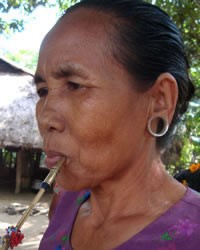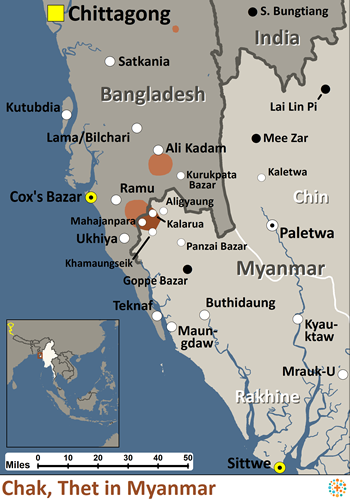The Chak are not related to the much larger Chakma tribe, who are also Buddhists and live in Rakhine State. Whereas the Chak speak a Tibeto-Burman language, Chakma is part of the completely different Indo-European family. In Myanmar the Chak have long appeared in official records as the Thet people and were listed under that name in the 1901 census, when they had a population of just 230, causing a British officer to lament, “They have practically disappeared, absorbed, for the most part, into the surrounding Rakhine population…. They seem likely to disappear altogether before long." Thankfully, the Chak did not vanish, and their population had recovered to 693 people three decades later at the time of the 1931 census.
Location: Despite their small population of less than 2,000 people in Myanmar, the Chak have a long and distinguished history. They inhabit 17 villages within Maungdaw and Sittwe districts in Rakhine (formerly Arakan) State in the extreme west of Myanmar. An additional 3,077 Chak people live in 14 villages in the Chittagong Division of nearby Bangladesh. The Chak homeland, sometimes referred to as the Blue Mountains, is isolated from outside influence. The Chak “inhabit small villages in a tropical rain forest. They rely on simple agriculture and hunting to survive and rarely venture outside their communities. Because of the political instability in this part of the world, the Chak have found it wiser to stay detached and isolated.”
Language: The Chak language is not closely related to other Tibeto-Burman varieties in the region, as it stems from a very different branch, labeled “Asakian.” Linguist David Bradley visited the Chak people in 2007 and found that only 1,000 out of 1,600 Chak people were still able to speak their language. His findings caused Chak to be placed on an international list of “threatened” languages.
The origins of the Chak people are uncertain, although it appears they may have diverged from the large Kadu tribe in the mid-13th century. Approximately 180,000 Kadu people still live in Myanmar's Sagaing Region today. Many Chak families fled into the Chittagong Hills in today's Bangladesh in the 14th century after their territory was overrun by the Rakhine. History repeated itself in the 21st century, with this corner of Myanmar in constant turmoil due to genocidal campaigns by the Burmese military to eradicate Muslim groups. Today, many areas in this part of Rakhine State have been laid waste, with landmines maiming many people as they go to collect bamboo or water. To escape the chaos, many Chak people have again crossed the border to live with their relatives in Bangladesh.
The powerful Buddhist kingdom of Mrauk-U ruled Rakhine State for 350 years until its influence began to fade in the 1780s. The kings were so wealthy that they even sent emissaries to Japan to hire Japanese samurai warriors to serve as bodyguards to the Mrauk-U royal family. Traditionally, Chak women were famous for wearing large earrings made of silver and bamboo.
Because they lived in the Buddhist stronghold of Mrauk-U for centuries, almost all Chak people profess Buddhism today, although they have retained many animistic rituals. Across the border in Bangladesh, Buddhism failed to impact the Chak to the same extent, and most people there continue to adhere to their traditional nat (spirit) worship.
Although a Catholic missionary from Portugal first visited Mrauk-U in the 1630s, very few Chak people have ever heard the Gospel in a way that enables them to grasp its importance, and even fewer have ever believed in Christ. Today, just a handful of Chak are thought to be Christians. Translation work to produce the first portion of the Bible in the Chak language is reportedly underway.
Scripture Prayers for the Chak, Thet in Myanmar (Burma).
| Profile Source: Asia Harvest Copyrighted © Used with permission |

























